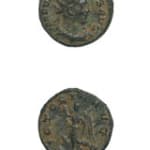Silvered Bronze Antoninianus of Emperor Valerian I, 253 CE - 260 CE
Silvered Bronze
C.4630
Further images
Obverse: IMP VALERIANVS AVG; Radiate and Draped Bust of the Emperor Facing Right Reverse: VICTORIA AVGG; Victory Walking to the Left, Holding a Wreath and a Palm Fron Publius Licinius...
Obverse: IMP VALERIANVS AVG; Radiate and Draped Bust of the Emperor Facing Right
Reverse: VICTORIA AVGG; Victory Walking to the Left, Holding a Wreath and a Palm Fron
Publius Licinius Valerianus was born at the end of the second century A.D., the precise year is unknown, to a noted Senatorial family. In 253 A.D., when serving as legate of the Rhine armies, he was raised to the rank of Augustus by his troops following the death of Emperor Gallus. Historically, Valerian has traditionally been viewed in a bad light. However, this has less to do with his ineffective rule than it does with his fervent persecution of Christians. In fact, Valerian seems to have been a gifted reformer. Some of his policies foreshadowed the reforms of Carus and Diocletian by dividing the empire into separate administrative halves. From 254 A.D. onwards, Valerian spent almost all his time in the East, suppressing various revolts and rebuking foreign invaders. Yet Valerian was distrustful of his lieutenants and preferred to lead the troops himself; unfortunately, Valerian could not be everywhere at once to deal with all the insurrections. Gothic pirates raided the Black Sea and the Persians were threatening the eastern frontiers, even briefly seizing Antioch. By 260 A.D., Valerian offered to meet the Persian King Shapur to discuss peace terms after the battling at the besieged town of Edessa. In a surprise move, Valerian was captured by the Persians and carried away in captivity. His fate was never discovered.
How many hands have touched a coin in your pocket or purse? What eras and lands have the coin traversed on its journey into our possession? As we reach into our pockets to pull out some change, we rarely hesitate to think of who might have touched the coin before us, or where the coin will venture to after it leaves our hands. More than money, coins are a symbol of the state that struck them, of a specific time and location, whether contemporary currencies or artifacts of a long forgotten empire. This stunning hand-struck coin reveals an expertise of craftsmanship and intricate sculptural detail that is often lacking in contemporary machine-made currencies. This ancient coin is a memorial to an emperor passed from the hands of civilization to civilization, from generation to generation that still appears as vibrant today as the day it was struck.
Reverse: VICTORIA AVGG; Victory Walking to the Left, Holding a Wreath and a Palm Fron
Publius Licinius Valerianus was born at the end of the second century A.D., the precise year is unknown, to a noted Senatorial family. In 253 A.D., when serving as legate of the Rhine armies, he was raised to the rank of Augustus by his troops following the death of Emperor Gallus. Historically, Valerian has traditionally been viewed in a bad light. However, this has less to do with his ineffective rule than it does with his fervent persecution of Christians. In fact, Valerian seems to have been a gifted reformer. Some of his policies foreshadowed the reforms of Carus and Diocletian by dividing the empire into separate administrative halves. From 254 A.D. onwards, Valerian spent almost all his time in the East, suppressing various revolts and rebuking foreign invaders. Yet Valerian was distrustful of his lieutenants and preferred to lead the troops himself; unfortunately, Valerian could not be everywhere at once to deal with all the insurrections. Gothic pirates raided the Black Sea and the Persians were threatening the eastern frontiers, even briefly seizing Antioch. By 260 A.D., Valerian offered to meet the Persian King Shapur to discuss peace terms after the battling at the besieged town of Edessa. In a surprise move, Valerian was captured by the Persians and carried away in captivity. His fate was never discovered.
How many hands have touched a coin in your pocket or purse? What eras and lands have the coin traversed on its journey into our possession? As we reach into our pockets to pull out some change, we rarely hesitate to think of who might have touched the coin before us, or where the coin will venture to after it leaves our hands. More than money, coins are a symbol of the state that struck them, of a specific time and location, whether contemporary currencies or artifacts of a long forgotten empire. This stunning hand-struck coin reveals an expertise of craftsmanship and intricate sculptural detail that is often lacking in contemporary machine-made currencies. This ancient coin is a memorial to an emperor passed from the hands of civilization to civilization, from generation to generation that still appears as vibrant today as the day it was struck.





